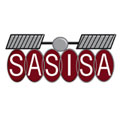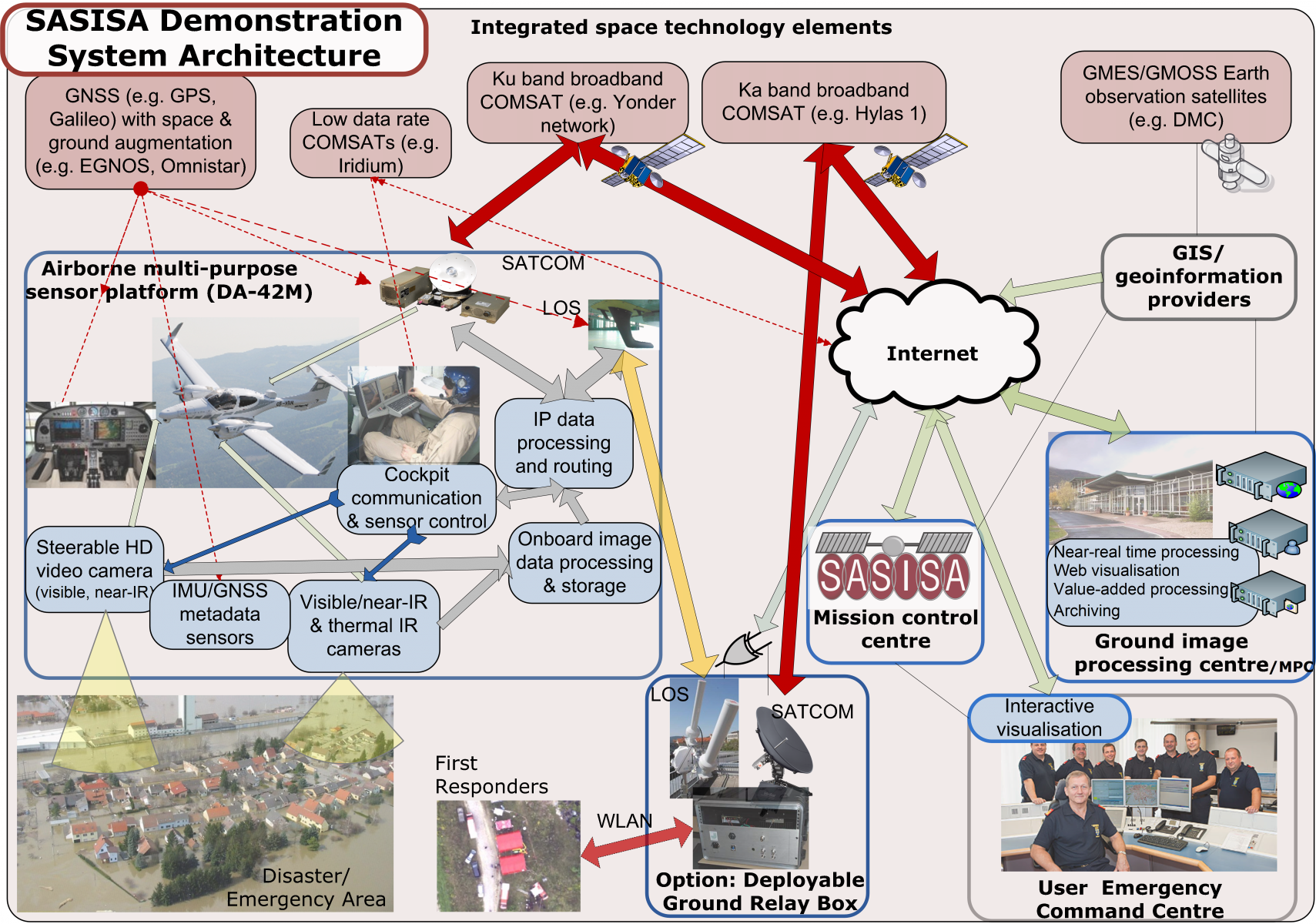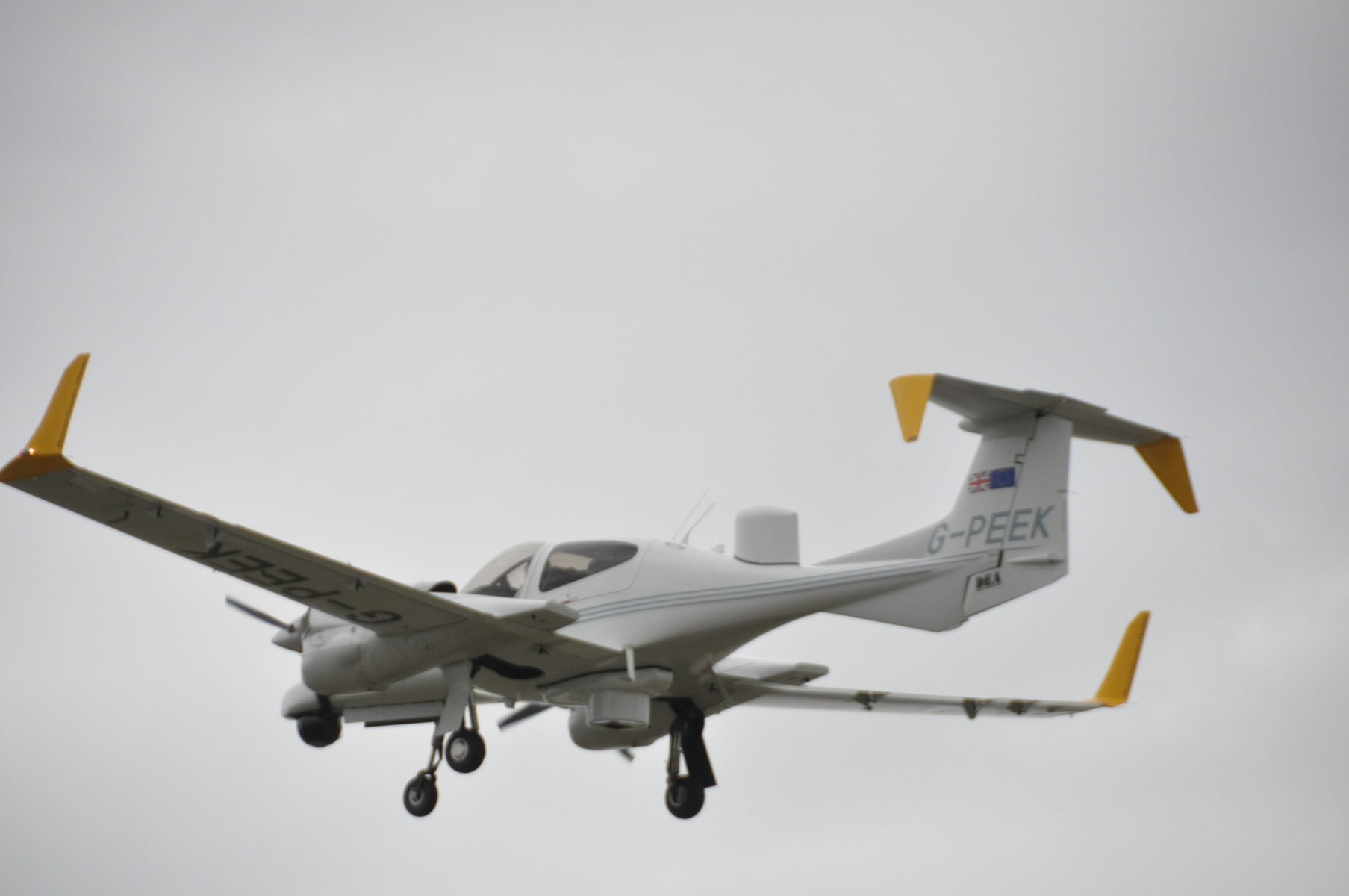
Objectives of the service
For airborne situational awareness support, SASISA combines existing technologies in a flexible, modular system that is designed to make the benefits of digitally networked, integrated technology available to civil emergency and disaster response communities in the EU.
Capabilities are demonstrated in realistic demo utilisation deployments in several countries to strengthen awareness, acceptance and support of the new service in emergency and disaster management communities, based on the integrated use of applied space technologies.
The demonstration system uses a Diamond DA42M multi-purpose small aircraft with pilot and operator, carrying a multisensor payload for still and moving images. Images are orthorectified on board and downlinked for visualisation in near real time during the mission over a Viasat Ku-band airborne satellite terminal for in-flight beyond line-of-sight Internet connectivity.
This enables the Mapping Production Centre at e-GEOS to generate integrated value-added post-processing products from aerial and satellite data, to and deliver them to users significantly faster than current rush-mode services.

Users and their needs
The SASISA service is designed for institutional users in the civil security sector with responsibility for disaster and emergency response and humanitarian assistance. The focus is on the European Union, but the geographical scope is not limited.
The participating and contributing users in the SASISA Demonstrations are:
- Department of Civil Protection and National Defence, Styria
- Department of Fire Service and Civil Protection, Lower Austria
- National Department for Civil Protection, Italy
- "emergency.lu", Directorate for Development Cooperation, Luxembourg.
To respond to disasters, users need
- to gain situational awareness for mission control and decision-making
- understand the dynamics and risks of the given situation and take best countermeasures at all times
- minimise damage to humans, property, infrastructure and the environment.
Bringing the benefits of real-time airborne sensing to the civil security sector empowers responders and lets them handle emergency situations more effectively and more confidently.
Relevant usage scenarios include:
- Limiting the damage during river floods, including monitoring the condition of embankments and flood defences;
- Responding to large fires, especially forest fires and other wildfires;
Responding to landscape-changing disasters (e.g. landslide, earthquake).
Service/ system concept
The modular system architecture with various sensor payloads and satellite communication beyond line of sight permits fast, effective emergency response and also facilitates other commercial utilisations of the same aircraft between activations in disaster events.
The solution demonstrated in SASISA offers three main benefits:
- IP-based, always on broadband connectivity via satellite on a small, manned multipurpose aircraft for instant delivery of situational awareness information over large distances beyond the radio line of sight, even when terrestrial networks are disrupted and the affected area on the ground inaccessible;
- adding the specific strengths of digital airborne sensing to the pool of integrated information sources available to disaster responders in a way that is affordable and easy to use, allowing airborne situational awareness to become a standard component of emergency management in the civil domain;
- a Europe-wide operational solution that combines with rapid-response satellite imagery and integrated thematic mapping for disaster response and emergencies.

Space Added Value
The airborne SASISA service uses two space technologies (Telecommunication and Navigation) and in addition, its operation and resulting data are closely combined with space-based Earth Observation to produce an integrated service and suite of products for users.
These three space technologies enable decisive improvements over current practices in terms of timeliness, reach and quality of situational awareness information.
- Satellite communication permits instant delivery of near-real time imagery and other remote sensing data from aircraft at distance, including in international disaster assistance scenarios.
- Satellite navigation is indispensible for precise geo-referencing of sensor data, locating each pixel so precisely that the result can be combined with other information sources such as GIS archives and satellite imagery to generate the value-added thematically enhanced mapping products users require.
High-resolution Earth observation from satellites (radar and optical) is already established as a key enabler for European emergency management, and can be further strengthened by integrating it with an in situ instant-reaction airborne element that also improves performance under cloud cover and adds rapid oblique-view capability.
Current Status
Airworthiness of the DA42M aircraft "G-PEEK" with the specialised SASISA mission payload configuration was certified by EASA in March 2015. This is the regulatory precondition for using it commercially.
Trials in support of integrating and testing the image capturing, processing, transmission and visualisation workflows were performed successfully in 2014/15.
The first SASISA demonstration deployment campaign was combined with a large, multi-scenario exercise on 15/16 May 2015, led by the Austrian Red Cross and the Lower Austrian civil protection agency, at Allentsteig training ground in Austria.
The second demo campaign was performed with the Italian National Civil Protection Department on 20/21 July 2015, operating the aircraft from Rome and covering wildfire scenarios in Campania and Calabria. More than 20 active wildfires in Southern Italy were spotted, captured and reported during the mission.
Key achievements of the project include:
- Successful integration and certification of onboard Ku-band broadband satellite connectivity on an affordable and versatile specialised mission aircraft.
- Validation of the required system capabilities and concept of operations of the SASISA service with users.
- Validation of the synergies between aerial and satellite imagery for purposes of very rapid delivery of European emergency management services
- Confirmation and refinement of possible strategies towards creation of a new airborne civil emergency response support service at the European institutional level within five years.
The project was concluded with the Final Review meeting on 17 December 2015.
Prime Contractor(s)
Subcontractor(s)








